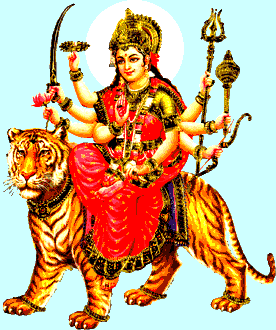Durga has a variety of names which are related to her many forms, attributes
and actions, but in popular art these are not always depicted accurately
or distinctively; besides there are regional variations which make the iconography
somewhat unstandardized. For example, Durga's mount is either a tiger or
a lion, and she has 8 or 10 or 18 arms, depending on the dominance of a
particular myth in the iconographer's region. She is often shown seated
upon a lion, and dressed in red, beautiful, with a fair complexion and many
arms. In her hands, she holds various weapons, among them a lance to kill
the demons, and sometimes a venomous snake.
In Bengal, the worship of Durga-especially in autumn and spring--provides
the occasion for the greatest Hindu festivities. Members of families who
happen to live apart in various places in the country come together for
the festival. The celebrations, with songs and dance, last ten days and
nights during which the goddess is believed to actually inhabit her images.
The last day is the greatest. Then, as the goddess has left them, the
images are carried in procession--with flowers, music, and bowls of burning
incense before them-to the Ganga into which they are immersed. The black
buffalo symbolized the demons whom Durga combats. For this reason hundreds
of buffaloes are sacrificed to her at the time of her festival. Lambs and
goats are also sacrificed, but never female animals, neither to her nor
to other goddesses.
Durga enjoys one of the greatest followings of worshippers and has many
names. In many popular pictures we find the goddess seated as Amba upon
a tiger. She holds in her several hands all the known symbolic weapons together
with the head of the demon she killed. With one of her hands, she blesses
her faithful worshippers, thus reassuring them that they should fear no
harm, for she is just.





